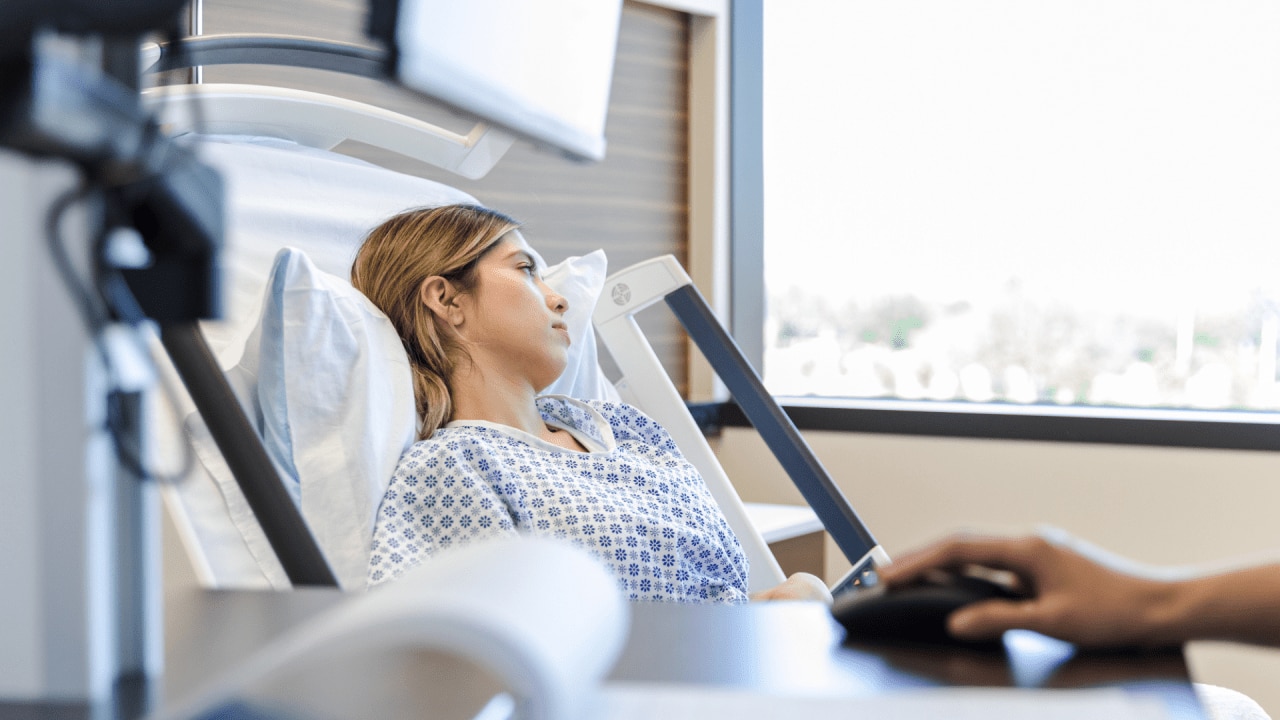
There’s been a rise in young women taking to TikTok to reveal they took drastic measures to cure their premenstrual dysphoric disorder, Bek Day explains.
Note: This article contains discussion of mental illness and self-harm
Sometimes, in the grips of premenstrual dysphoric disorder (PMDD), Caitlin* would rack up thousands of dollars in credit card debt.
At its worst, the condition made the 38-year-old Sydney woman fearful for her life.
“At times, I felt suicidal, like I was a burden on everyone who loved me,” she recalls sadly, “it is such a messed up thing, to be a bubbly, positive person for two weeks out of the month, and to feel as though your body is inhabited by some sort of destructive, depressive force for the other two. You begin to forget who the real version of you is.”

Like what you see? Sign up to our bodyandsoul.com.au newsletter for more stories like this.
It’s a refrain common in the PMDD community online, a world populated by women supporting each other through the trenches of navigating a psychological disorder that has only been officially listed in the Diagnostic and Statistical Manual of Mental Disorders (DSM V) for around a decade.
PMDD – an extreme form of PMS – is often marked by severe behavioural, psychological and physical symptoms that are often debilitating.
Paranoia, anxiety, panic attacks, depression and dissociation are some of the mental symptoms while bloating, back pain, leg cramps and nausea can be among the physical indications of the disorder.
“We know that part of the cause of PMDD is the body’s reaction to the hormonal changes it goes through in the lead-up to menstruation,” explains Dr Aman Bhinder, women’s wellness specialist and integrative GP.
“It is 100 per cent one of the most underdiagnosed problems, and so often it’s written off as anxiety or depression because it’s hard for people in the grips of these symptoms to chart when they’re occurring and to notice the pattern. One of the hardest barriers to treatment is getting the correct diagnosis”.
Caitlin agrees. “I had to go to my doctor with the term after finding out about it online, even after years of seeing psychologists who assumed the problem was solely mental and not hormonally-based,” she says. “And if diagnosis is hard, finding a treatment that works can be a soul-destroying process. And the whole time you’re expected to just ‘wait and see’ if this version of birth control or that implant or that antidepressant will actually help your symptoms.”
It was this feeling of helplessness – spurred on by a growing cohort of sufferers on TikTok who share resources and information – that prompted Caitlin to seek out a full hysterectomy and oophorectomy (removal of the ovaries) at just 38 years old.
Tens of thousands of videos under the hashtags #PMDD and #PMDDawareness populate the platform, filled with the experiences of women who have been navigating the condition for many years.
Post-op diaries from women who have undergone radical oophorectomy and hysterectomies, updates from those who have undergone chemical menopause and diary-style entries from those sharing their symptoms all rack up views in their thousands, and for Caitlin – who for the years prior to her diagnosis felt very alone in her suffering – provide a much-needed lifeline.
“Because of my age and the fact that I don’t have children, my doctor was at first hesitant to do the surgery,” says Caitlin, “but actually, once I was able to convince her that I’d exhausted all other options, based on a lot of women’s testimony that I’ve connected with online, she was more open to the idea.”
While Caitlin is yet to undergo the surgery, she is hopeful that putting her body into menopause is the answer.
“It’s certainly an extreme treatment, and one I haven’t personally seen women pursue,” explains Dr Bhinder, “but because PMDD is a menstrual issue, once a woman stopped menstruating she would no longer be able to suffer from PMDD.”
Dr Bhinder adds that for women who still want to pursue natural pregnancies, however, this is not an option, and as a result, urges women suffering from PMDD to seek out less-invasive options tailored for them.
“There is no one-size-fits-all treatment for this, because it depends so much on the individual,” she explains.
“There are a number of natural remedies such as diet changes in the luteal phase [roughly two weeks before your period] as well as supplements like chaste berry and magnesium, all the way through to medical treatments for anxiety and depression – often only taken in the luteal phase – and bio-identical hormones.”
Dr Bhinder emphasises the importance of finding the right practitioner to work with, acknowledging it can be an uphill battle.
“We know all about postnatal depression (PND) because there is a baby involved, and typically people focus more on the baby’s wellbeing than the mother’s. With PMDD, seeing as it usually just involves the women, so many patients don’t even get a diagnosis.”
For Caitlin, the surgery doesn’t represent the end of her reproductive years, but the beginning of a life free from PMDD.
“Obviously, everyone needs to figure out what works for them, in consultation with their doctor,” she says, “but the idea of not being held captive by this dark force that comes like clockwork every month, is so exciting for me. For the first time in a long time, I am hopeful for a normal, happy life.”
*Names have been changed